Abstract
Yersinia enterocolitica is one of the few human pathogens that grows at the proper food refrigeration temperatures of 0 to 5 degrees C. Although the isolation of environmental biotypes of Y. enterocolitica from many types of food and water has been reported in the literature, the recovery of the sensitive strains inoculated into foods has been slow and uncertain. Rapid recovery of several clinical strains inoculated into meats was accomplished by using two modified selenite broths without added nutrients. It was critical to restrict the sample size of the blended meat suspension at the 0.2-g/100 ml level, thereby restricting the growth of the total bacterial population in the selenite enrichment media. Otherwise, the slower growing Y. enterocolitica would be overwhelmed by the faster growing normal bacterial flora from the meat. Both the resistant serotype O:3 and the sensitive O:8 clinical isolates of Y. enterocolitica were recovered from the modified selenite enrichment media after 2 and 3 days of incubation at 22 degrees C.
Full text
PDF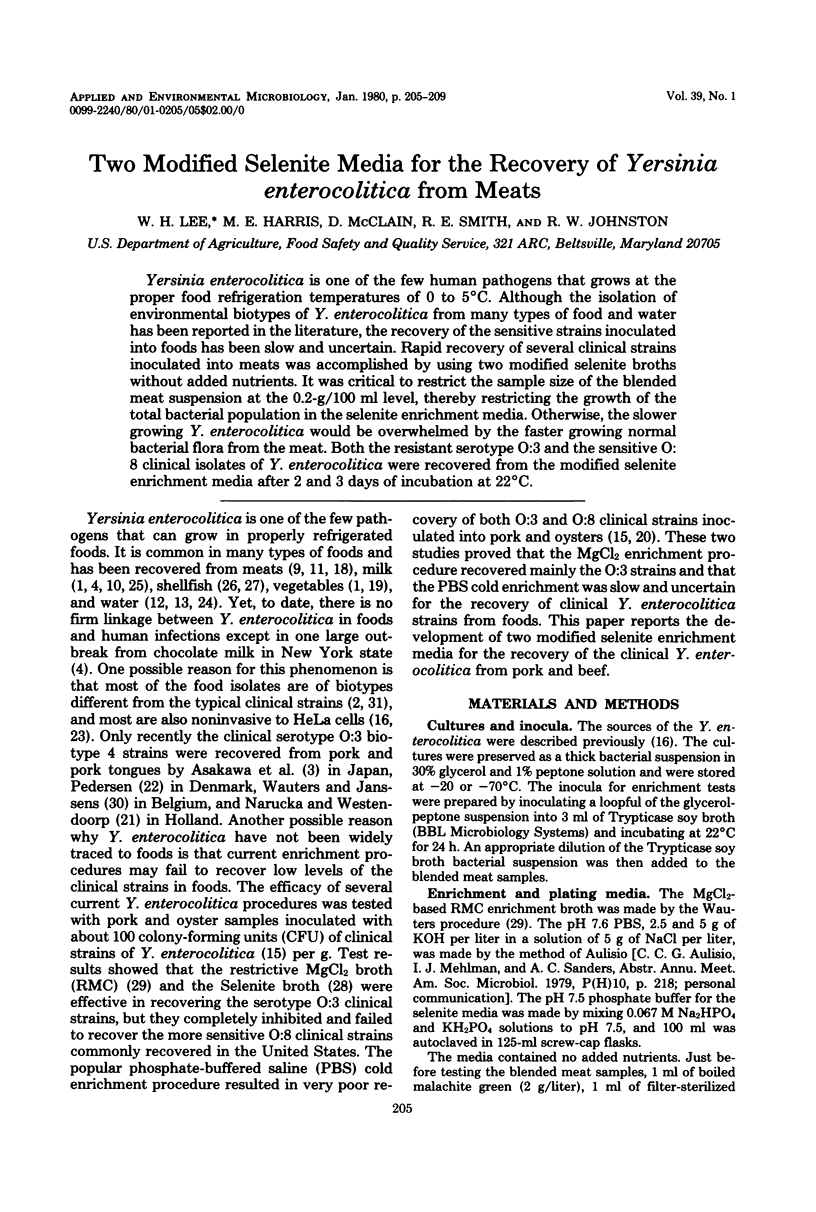
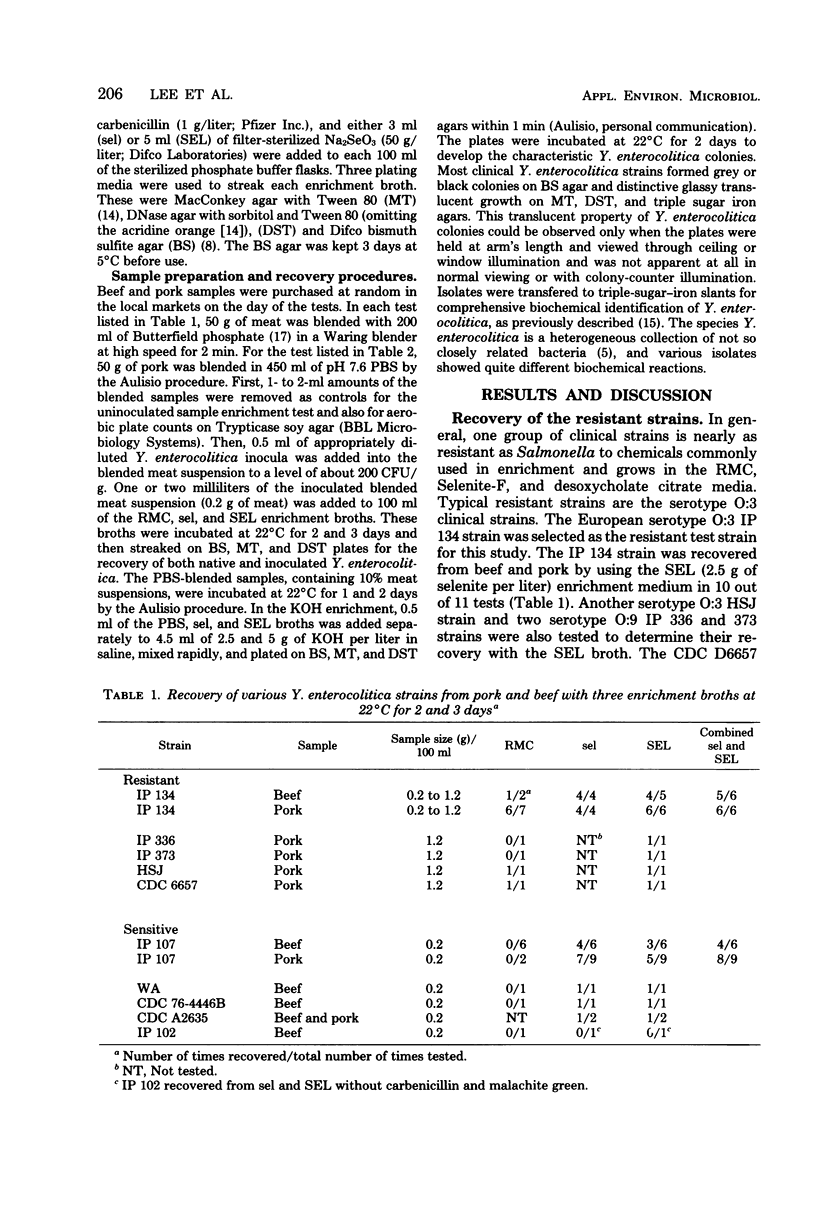
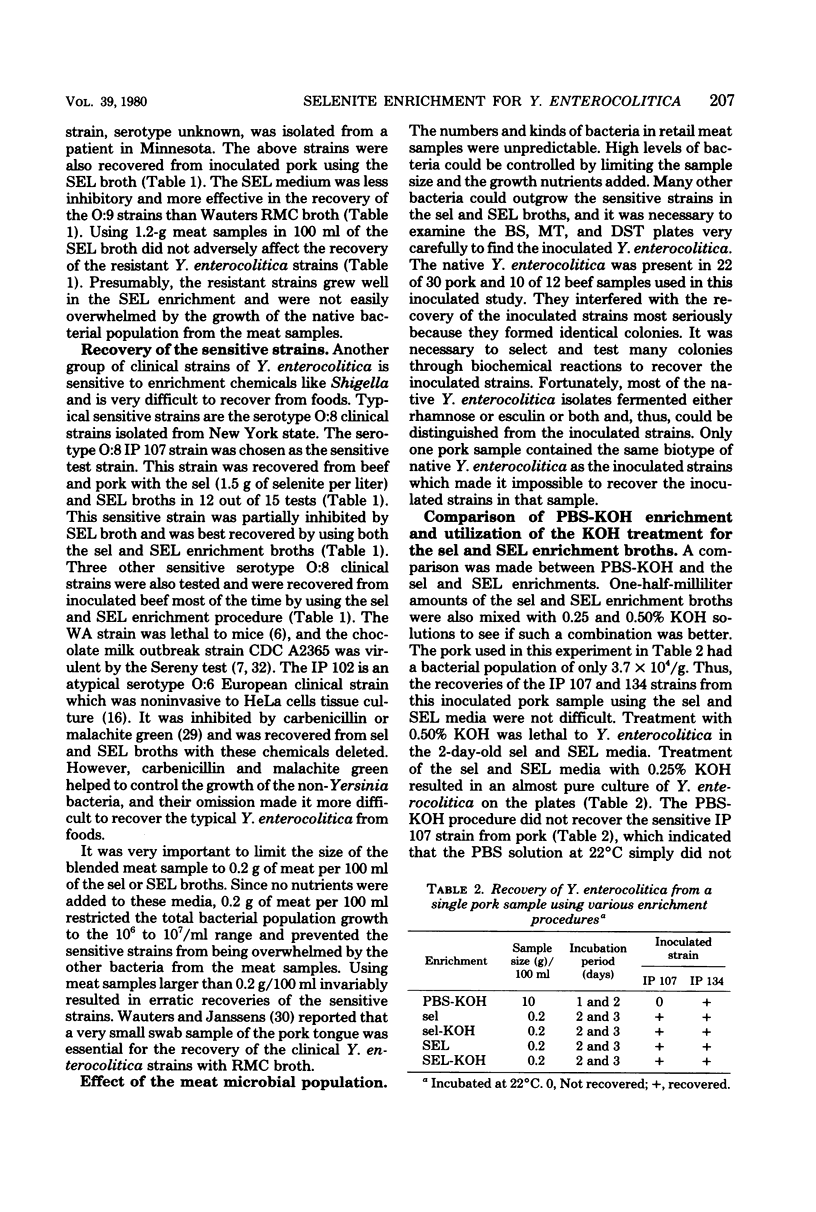
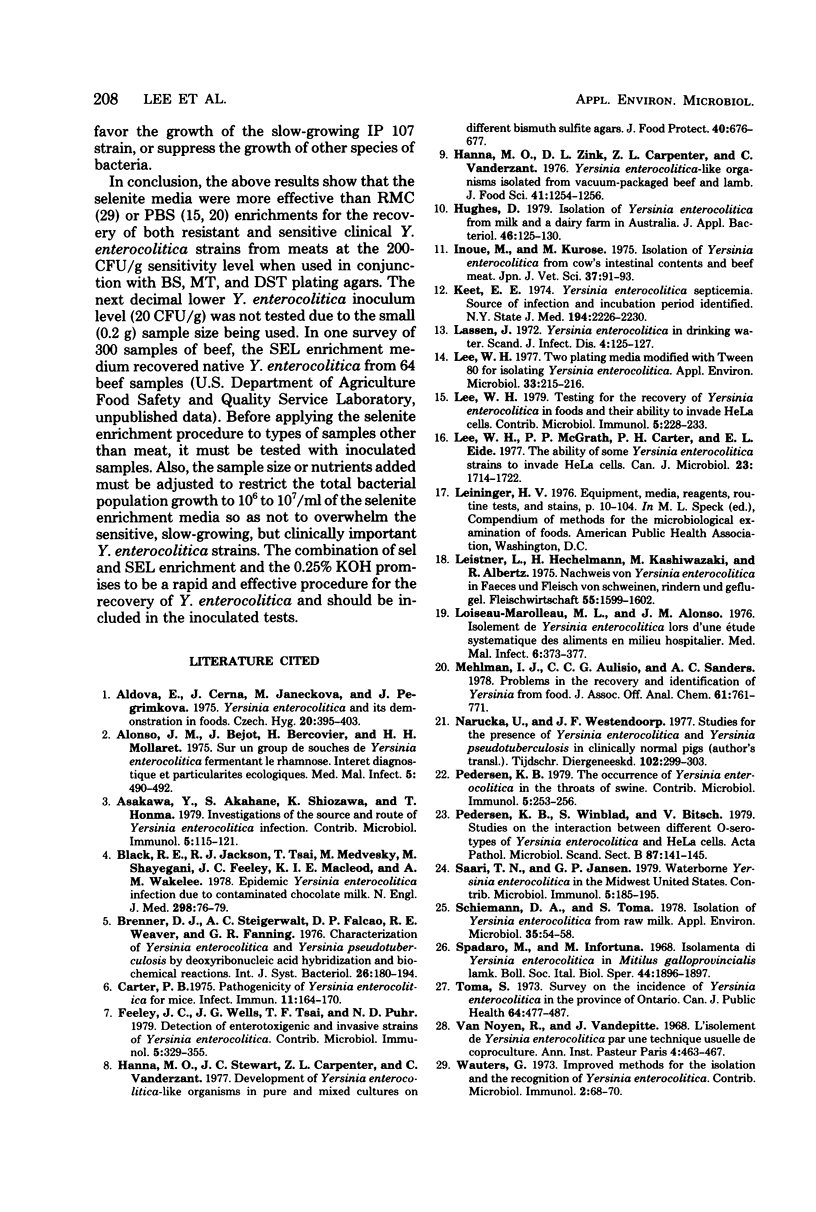
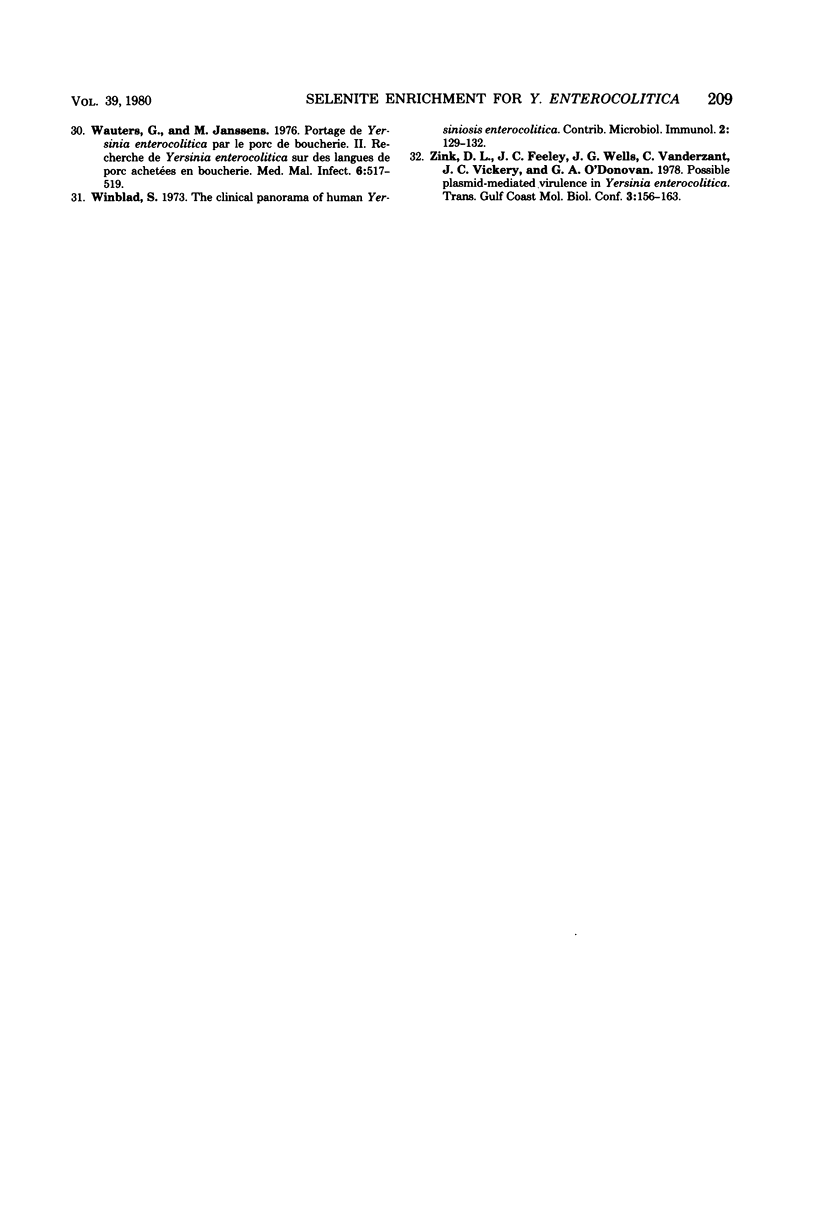
Selected References
These references are in PubMed. This may not be the complete list of references from this article.
- Asakawa Y., Akahane S., Shiozawa K., Honma T. Investigations of source and route of Yersinia enterocolitica infection. Contrib Microbiol Immunol. 1979;5:115–121. [PubMed] [Google Scholar]
- Black R. E., Jackson R. J., Tsai T., Medvesky M., Shayegani M., Feeley J. C., MacLeod K. I., Wakelee A. M. Epidemic Yersinia enterocolitica infection due to contaminated chocolate milk. N Engl J Med. 1978 Jan 12;298(2):76–79. doi: 10.1056/NEJM197801122980204. [DOI] [PubMed] [Google Scholar]
- Carter P. B. Pathogenecity of Yersinia enterocolitica for mice. Infect Immun. 1975 Jan;11(1):164–170. doi: 10.1128/iai.11.1.164-170.1975. [DOI] [PMC free article] [PubMed] [Google Scholar]
- Feeley J. C., Wells J. G., Tsai T. F., Puhr N. D. Detection of enterotoxigenic and invasive strains of Yersinia enterocolitica. Contrib Microbiol Immunol. 1979;5:329–334. [PubMed] [Google Scholar]
- Hughes D. Isolation of Yersinia enterocolitica from milk and a dairy farm in Australia. J Appl Bacteriol. 1979 Feb;46(1):125–130. doi: 10.1111/j.1365-2672.1979.tb02589.x. [DOI] [PubMed] [Google Scholar]
- Inoue M., Kurose M. Isolation of Yersinia enterocolitica from cow's intestinal contents and beef meat. Nihon Juigaku Zasshi. 1975 Feb;37(1):91–93. doi: 10.1292/jvms1939.37.91. [DOI] [PubMed] [Google Scholar]
- Keet E. E. Yersinia enterocolitica septicemia. Source of infection and incubation period identified. N Y State J Med. 1974 Nov;74(12):2226–2230. [PubMed] [Google Scholar]
- Lassen J. Yersinia enterocolitica in drinking-water. Scand J Infect Dis. 1972;4(2):125–127. doi: 10.3109/inf.1972.4.issue-2.11. [DOI] [PubMed] [Google Scholar]
- Lee W. H., McGrath P. P., Carter P. H., Eide E. L. The ability of some Yersinia enterocolitica strains to invade HeLa cells. Can J Microbiol. 1977 Dec;23(12):1714–1722. doi: 10.1139/m77-247. [DOI] [PubMed] [Google Scholar]
- Lee W. H. Testing for the recovery of Yersinia enterocolitica in foods and their ability to invade HeLa cells. Contrib Microbiol Immunol. 1979;5:228–233. [PubMed] [Google Scholar]
- Lee W. H. Two plating media modified with Tween 80 for isolating Yersinia enterocolitica. Appl Environ Microbiol. 1977 Jan;33(1):215–216. doi: 10.1128/aem.33.1.215-216.1977. [DOI] [PMC free article] [PubMed] [Google Scholar]
- Mehlman I. J., Aulisio C. C., Sanders A. C. Microbiological methods. Problems in the recovery and identification of Yersinia from food. J Assoc Off Anal Chem. 1978 Jul;61(4):761–771. [PubMed] [Google Scholar]
- Narucka U., Westendoorp J. F. Een onderzoek naar het voorkomen van Yersinia enterocolitica en Yersinia pseudotuberculosis bij klinisch normale varkens. Tijdschr Diergeneeskd. 1977 Mar 1;102(5):299–303. [PubMed] [Google Scholar]
- Pedersen K. B. Occurrence of Yersinia enterocolitica in the throat of swine. Contrib Microbiol Immunol. 1979;5:253–256. [PubMed] [Google Scholar]
- Pedersen K. B., Winblad S., Bitsch V. Studies on the interaction between different O-serotypes of Yersinia enterocolitica and HeLa cells. Acta Pathol Microbiol Scand B. 1979 Apr;87B(2):141–145. doi: 10.1111/j.1699-0463.1979.tb02417.x. [DOI] [PubMed] [Google Scholar]
- Saari T. N., Jansen G. P. Waterborne Yersinia enterocolitica in the midwest United States. Contrib Microbiol Immunol. 1979;5:185–195. [PubMed] [Google Scholar]
- Schiemann D. A., Toma S. Isolation of Yersinia enterocolitica from raw milk. Appl Environ Microbiol. 1978 Jan;35(1):54–58. doi: 10.1128/aem.35.1.54-58.1978. [DOI] [PMC free article] [PubMed] [Google Scholar]
- Spadaro M., Infortuna M. Isolamento di Yersinia enterocolitica in Mitilus galloprovincialis Lamk. Boll Soc Ital Biol Sper. 1968 Nov 30;44(22):1896–1897. [PubMed] [Google Scholar]
- Toma S. Survey on the incidence of Yersinia enterocolitica in the province of Ontario. Can J Public Health. 1973 Sep-Oct;64(5):477–487. [PubMed] [Google Scholar]
- Van Noyen R., Vandepitte J. L'isolement de Yersinia enterocolitica par une technique usuelle de coproculture. Ann Inst Pasteur (Paris) 1968 Apr;114(4):463–467. [PubMed] [Google Scholar]


